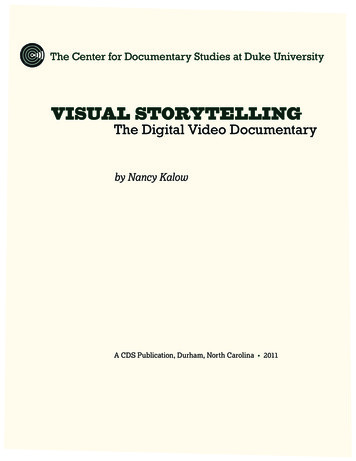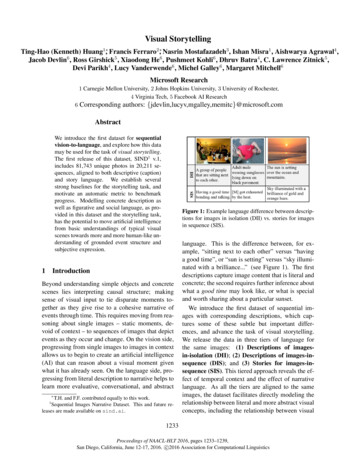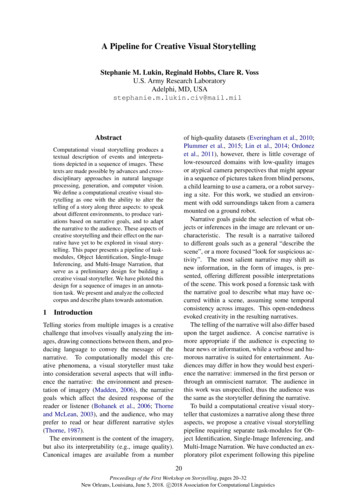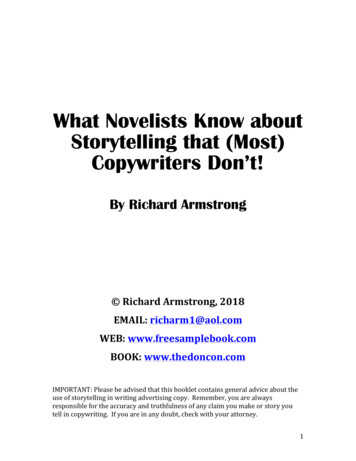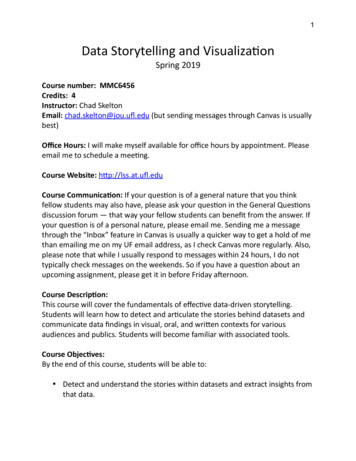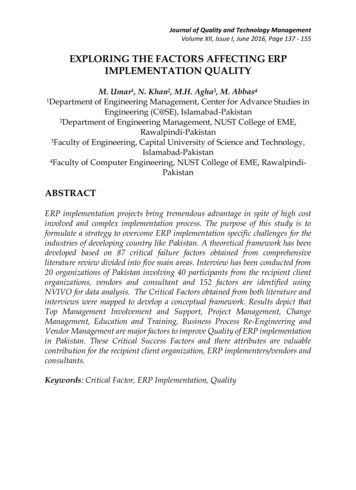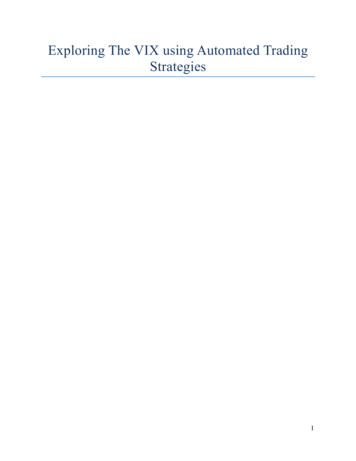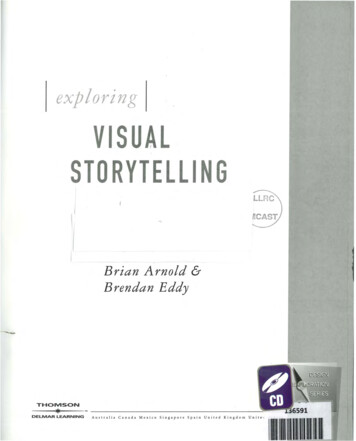
Transcription
exploringVISUALSTORYTELLINGBrian Arnold &Brendan Eddy*THOMSON- N'NG '0"" '"591C,",",M",," """0"" ",'" U"''''"",'o mU"",11 IIIIIIIIII
contentsPrefacevTools of the Trade1The purpose of this chapter is to introduce readers to the tools ofthe storytelling tra de., Tools include intangible assets like talent andpassion, but also cdncrete pieces like scripts and storyboards.Context28Context is how various pieces of the story work in relation to oneanother. Readers learn about the framework of the story: exposition,conflict! dialogue, motives and values, and plants and payoffs.Character50The characters are the most important piece of the story. They are thestand-in for the audience members, and the reader will learn how toget the audience to understand them and feel empathy for them.Conflict68This chapter explores the crux ofthe story-conflict. Conflict iswhat happens to the characters to drive the plot. This chapterexplores how to introduce conflict, how to create tension, and howto build action.PlotPlot is the structure of the story, the through line that the charactersand events move along. This chapter provides an introduction to theparts of the story, from beginning to end, and gives readers the skillsto build a new world using storytelling.86
IVI contents ISpace and Time108This chapter explores ways to establish a story's space and time, teachingreaders about shots and transitions, scenes, sequencing action, andintroducing them to the concepts of two- and three-dimensional space.ITwo-Dimensional Space122For storytellers who work with a two-dimensional space, this chapterprovides assistance with composition and establishing spatialrelationships.Three-Dimensional Space138This chapter provides more in-depth information about working in a threedimensional space. Storytellers have to set up their shots to provide asmuch information as possible. This chapter explores the visual cuesstorytellers can provide to help their audience, from staging to cameraplacement.Staging over Time158The story plays out over time. The audience gets to know the characters,the problem, and follows the story through the events that transpire.Readers learn how to edit before the camera even begins to roll, so thatthe story is pared down to answer the audience's three basic questions.Story-Shaping Questions174Pulling it all together takes a lot of work. This wrap-up chapter reviews allthe concepts the readers have been introduced to, and helps them reviewthe critical information.GlossaryIndex185190
indexNote: Page numbers followed by"f"indicate that the entry is included in afigure.Act, ll8, 118fActions, 30Arc, character's. See Cqaracter arc, 14,53-55Antagonist, 62, 63, 63fAnticipation, 71, 167Audiencederives meaning from stakes, 80-83describe?, 9-11emotional link to, 34, 58-61, 58f-6lf,82f,170fevent and, 88guided discovery, 41 fmeaningful events, 79fovercoming obstacles, 11, 92f, 106reluctance to change, 73rule of threes, 99scenes of decision/realization, 11-12showing - how to feel, 130-133line, 133, 13lf, 132f, 133fshape, 133-135, 133f, 134fshowing - where to look, 128-129, 129fline, 129, 130fshape, 130sincerity, 105-106stakes, 80, 8lftension, 7lf, 8lfthree questions, 167-170translation of intangibles intotangibles, 40understanding status quo, 99fAudience questions, 167How should I feel about it? 169-170What is going on? 167-168, 168fWho is involved? 169Beat, ll4, ll5f, 160Beginning of story, 99, ll9Brainstormingcluster, 178fdefined,17described, 17-19story-shaping, 178-179, 178ftimeline for, 18tips for, 18-19writing about people, 19writing about places, 19writing about situations, 19Brevity, 38Camera angle, 148, 149down-angle shot, 150-151in staging shot, 14lfstraight-on shot, 149, 150fup-angle shot, 150, 15lfCamera distance, 141-142close-up shot, 145, 147fextreme close-up shot, 146full shot, 143-144, 143f, 144flong shot, 142-143, 142fmedium shot, 144, 145f, 146fin staging shot, 14lfCamera placement, 148, 149fcamera angle, 149down-angle shot, 150-151straight-on shot, 149, 150fup-angle shot, 150, 15lf
line of engagement, 152, 153f, 154f180-degree rule, 152-154, 154fCatalystdefined,35through line, 88, 90-91, 9lfused to facilitate change, 100Catharsis, 10Change. See Arc, character's; Forcedchange; Internal changeCharacter. See also specific type of characterappearance of, 44farc. See Character arcas obstacle, 95change, 14, 74f, 9lf, 177choices of, 44f, 73, 73f, 75, 92f, 114in conflict, 70fdefined,52described, 50-53establishing, 168goals, 33f, 78-79, 78f, 80f, 8lf, 102fhumor, 59f, 6lfinspiration for, 178-179kindness, 59fmost important storytellingingredient, 90, 95obstacles, overcoming, 14,35,53-55,56f, 6lf, 74f, 9lf, 92f, 177pain,60fplot, 95f, 95-96revealing character, 55establishing universal empathy,58-62peeling the onion, 57universals, 55-56rule of threes, 14through line, 90values. See ValuesCharacter arc, 14,53-55,94,95,177Character lock, 72-75, 73f, 74fChoicesof character, 44f, 73, 73f, 75, 92f, 114personal values, 12, 12fstakes,77fChronological order, 162, 164Climax, 100Close-up shot, 117, 117f, 145, 147fextreme, 146Color,135Composition, 124-126, 125faudience information, 170lines, 125, 126, 126fshapes, 125, 126f, 126-127spatial relationships, 127-128,127f,128fstaging for effective - , 148Concept-formation, 19-21Conflictin context, 35-36, 37fdefined,70described,68-70e trapolating,93forced action and character lock,72-75, 73f, 74fstakes, 75-76, 76f, 77f, 78faudience derives meaning from,80-83showing character cares about goal,78-79, 78f, 80f, 8lftension, 71-72, 7lfthrough line, 90, 91, 92f, 93Consistency, 105, 177Contextdefined,30described, 28-30conflict, 35-36dialogue, 36-38exposition, 31-34goal of story, 31motives and values, 43-44tangibles and intangibles, 39-43establishing meaning for conflict, 80images, 125
192I Exploring Visual Storytelling Iplants and payoffs, 45-47pre-visualization, 161Continuityjump in, 115. See also Transitionspre-visualization, 162Contrast, 13-14, 13f, 97f, 128, 169Cut, 113, 113f, 116, 154f, 161Daydreaming and storytelling, 8fDeath as highest stake, 77f11, 165Decisions, scenesDepth, 142;Diagonal line, 130, 130f, 132, 132f,133,133fDialogue, 30, 36-38, 170Disbelief, dispelling of, 154Dissolve, 115fDominaht shape, 134, 134fIDown-ahgle shot, 150-151Dynamic tension, 98of,establishing context for, 80experience of entire context, 47fmeaningful to audience, 79fplot, 95-96Expectation, 71Exposition, 31-34, 35, 37f, 161Externalize, 41Extrapolating the conflicts, 93Extreme close-up shot, 146Facts,32fFade-in, 116Fade out, 116Feedback, for professional growth, 25Film time, 117Forced action, 72-75, 73f, 74fForced change, 53-54Form, 127Formats, linear and nonlinear, 14-15Frame, 112Fullshot143-14 143 144 168Edge pieces, 176-177Editing before you shoot, 160defined, 160linear and nonlinear editing, 163, 164f,165f, 165-166, 166fpre-visualize final product,161-162, 162fEdits, 115-117Emotional experience, 31, 34Emotions, 40-43, 43fEmpathic link, 31, 34audience caring about character, 82festablishing universal empathy, 58-62peeling the onion, 57universals, 55-56End of story, 104, 119Environment, changing, 74fEstablishing shot, 114, 168Eventsbelief of extraordinary, 47fdefined, 88Goalcharacter, 33f, 53-55, 63f, 102f, 177first attempt at, 102fmutually exclusive, 35objective at stake, 76fpassion for, Sf, 7fshowing character cares about, 78-79,78f, 80f, 81 of story, 31Guided discovery, 41 Hero, 52. See also Main characterHorizontal line, 130-131, 130f, 131 , 133How should I feel about it? (audiencequestion), 169-170Humor, character and, 59f , 61 Idea, formation of, 9Image, framework of. See CompositionImplied line, 129
indexInciting incident, 88, 89f. See also CatalystIntangibles, 39-43emotions, 43finvisible intangibles, 43fmotives/values, 43fInternal change, 54fInvisible intangibles, 43fJump in continuity, 115. See alsoTransitionsKindness, character and, 59fLight, 135Lineand composition, 125, 126, 126fimplied, 129orientation, 130showing audience how to feel, 13 , 131 ,132f, 133fshowing audience what to see, 129, 130fLinear editing, 163, 164f, 165f,165-166, 166fLinear formats, 14-15Line of engagement, 148, 152, 153f, 154f,165-166Line orientation, 130diagonal, 130, 130f, 132, 132f, 133, 133fhorizontal, 130-131, 130f, 131 , 133vertical, 130, 130f, 131-132, 131 , 133Location and plot, 95-96, 96 , 97fLong shot, 116, 117f, 142-143, 142fLow point, 101 Main characterdefined, 10described, 52-53, 52fMedium shot, 144, 145f, 146 Mentor, 62, 64Middle of story, 100-10 1, 103-104, 119Mood, 177Moral compass, 64fMotives, 43-44, 43f, 177Mutually exclusive goals, 35Nonlinear editing, 163, 164f, 165f,165-166, 166fNonlinear formats, 14-15Object, three-dimensional, IIIObstacle character, 62, 63, 63f, 95, 177Obstacles, overcomingI catalyst, 91 ; change, 74f, 177, character's attempt at, 14,35,53-55,56f, 61 , 78, 92fdescribed, 11main character, 52fplot, 94, 77tension, 72180-degree rule, 148, 152-154, 154fOutlining, 19-21Pain, character and, 60fParadox, 104Passion, 3-9for goal, 5f, 7fmultiplier of talent, 4fand process of visual storytelling, 6fPayoff information, 45-47, 46fPeople, writing about, 19Persistence of vision, 112Perspective character, 53, 62, 177Pitch, 25story beat, 25Placesestablishing, 168writing about, 19Planting information, 45, 45-47, 45fPlotcharacter, location, event, 95-96,95f,96fconflict driving - , 70fdescribed, 86-88I193
194I Exploring Visual Storytelling Ifacilitates change, 88placement of obstacles, 177points, main character and, 52fscene construction, 96, 97f, 98story vs., 93f, 93-95three-act structure, 98beginning, 99end, 104middle, 100-101, 103-104through line, 88, 89f, 90catalyst, 90-91, 91 character, 90;conflict, 91, 92f, 93twists, 104world-building (trust and suspension),104-106Post-productiondefined,. 15Pre-produttionbrainstorming, 17-19writing about people, 19writing about places, 19writing about situations, 19concept-formation, 19-21cost-effectiveness of process, 15-17, 16fdefined, 15described, 15-17outlining, 19-21pitch, 25pre-visualizing, 161primary focus of work, 17fscriptwriting, 21-22, 22fshot lists, 23storyboards, 23-25, 24fPre-visualize final product, 161-162,161 , 162fPrimary element, 25Productiondefined, 15standard visual storytelling pipeline, 15fPromptsstory-building, 179-184visual, 185Prose vs. visual story, 113Protagonist, 52. See also Main characterPure cinema, 171, 172fRealization, scenes of, 12Reflection, 167Resolution, 103Riskaudience and, 81 forced action, 73Ruleas tool, 2of threes, 14, 88Sceneconstruction, 96, 97f, 98continuous, 116fdefined, 96rule of threes, 14space and time, 114tensions, 128Scripts, 21-22, 22fScriptwriting,21Sequence, 117-118, 117f, 165Shapecomposition, 125, 126f, 126-127defined, 141dominant, 134, 134fheight of, 133fshowing audience how to feel, 133-135,133f,134fshowing audience what to see, 130Shot, 114fclose-up, 117, 117f, 145, 147fcomposition, 125defined, 113down-angle, 150-151establishing, 114, 168
Iextreme close-up, 146full, 143-144, 143f, 144f, 168information revealed by, 171long, 116, 117f, 142-143, 142fmedium, 144, 145f, 146fseries of - to create illusion, 163, 165fstaging single, 140-141 , 140f, 141 straight-on, 149, 150fup-angle, 150, 151 fwide, 168Shot lists, 23Showing vs. telling, 34, 36Sidekick,62,63,66fSincerity, 105-106Situations, writing about, 19Space, 1103-D space, 111112-D camera space, 111 , 111-112ISpatial relationships and composition,127-128, 127f, 128fStagingdefined, 140over time, 158-160audience's three questions, 167-170editing before you shoot, 160-166pure cinema, 171shot reveals new information, 171single shots, 140, 141 , 148Stakesaudience derives meaning from, 80-83death as highest, 77fdescribed,75-76escalation in story, 78f, 103fgoal as - in story, 76f, 102fshowing character cares about goal,78-79, 78f, 80f, 81 Status quo, 31, 32f, 34f, 99Story. See also Story-shapingdefined,2goal of story, 31plot vs., 93f, 93-95rule of threes, 14space and time, 119three-act structure, 98beginning, 99, 119end, 104, 119middle, 100-101, 103-104, 119Story arc, 94Story beat, 25Storyboards, 23-25,24fStory-building prompts, 179-184Story-shapingbrainstorming, 178-179, 178fdescribed, 176questions, 174-176, 177fpulling story together, 176-177story-building prompts, 179-184visual prompts, 185Straight-on shot, 149, 150fSubjective camera, 160Sup o rting characters, 62-65, 177Suspension (world-building), 104-106Suspension of disbelief, 105Sympathy, audience and, 58ITalent, 3-9passion as multiplier of, 4fvariety of forms, 4fTangibles, 39-43Task, breaking down complex, 20fTensionaudience experiencing, 81 described, 71-72, 71 scene, 128Three-act story structure, 15,98, 118fbeginning, 99end,104middle, 100-101, 103-104Three-dimensional space. See 3-D space3-D spacecamera distance, 141-142close-up shot, 145, 147findexI195
196I Exploring Visual Storytelling Iextreme close-up shot, 146full shot, 143-144, 143f, 144flong shot, 142-143, 142fmedium shot, 144, 145f, 146fcamera placement, 148, 149fcamera angle, 149line of engagement, 152, 153f, 154f180-degree rule, 152-154, 154fdescribed, llO, 11Of, lll, 138-140staging single shots, 140-141 f, 140f, 141 f2-D camera spaceh 24f, 127-128Threes, rule of, 14 ;Through line, 88, 89f,' 90catalyst, 90-91, 9lfcharacter, 90conflict, 91, 92f, 93Time, 110Time-basfd media, 112Timeline for brainstorming, 18Time management skills, 78Tone, 177Tools, rules as, 2Transformation, 105Transitions, ll5-117Tricks of visual storytelling, 13contrast, 13-14, 13flinear and nonlinear formats, 14-15rule of threes, 14Trust (world-building), 104-106Twists, 1042-D camera spacecolor and light, 135composition, 124-126, 125fline 125, 126, 126fshapes, 125, 126f, 126-127spatial relationships, 127-128,127f, 128fdescribed, 110, lllf, lll-112,122-124, 124fshowing audience how to feel, 130-133line, 133, 13lf, 132f, 133fshape, 133-135, 133f, 134fshowing audience where to look,128-129, 129fline, 129, 130fshape, 130Two-dimensional camera space. See2-D camera spaceUnive
Exploring Visual Storytelling I facilitates change, 88 placement of obstacles, 177 points, main character and, 52f scene construction, 96, 97f, 98 story vs., 93f, 93-95 three-act structure, 98 beginning, 99 end, 104 middle, 100-101, 103-104 through line, 88, 89f, 90 catalyst, 90-91, 91 character, 90 ; conflict, 91, 92f, 93 twists, 104 world-building (trust and suspension), 104-106 Post .
